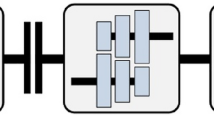Abstract
Eco-drive methods are being applied in modern passenger cars in the form of LCD displays showing real-time fuel consumption rates. The eco-drive is one of the most promising methods to enhance the fuel economy of vehicles. The ecodrive method can be made more effective by using the fuel-cut function. The fuel is not injected when the driver does not depress the gas pedal of a vehicle with engine speeds higher than approximately 1,500 rpm above the mid-vehicle speed range. This function is known as the fuel-cut function, and almost every modern vehicle is equipped with this function. The fuel-cut is most frequently activated on downhill sections of highway. Therefore, the CO2 exhausted from the vehicle can be zero in this downhill section. In this study, the fuel-cut function is simulated with CRUISE of AVL to find the most effective driving pattern in downhill sections. Simulations with the CRUISE software showed that the lower limit of the vehicle speed for fuelcut should be raised to improve fuel economy on steeper downhill sections. The fuel economy can be optimized when the fuelcut coasting and reacceleration is completed in the downhill part of the road. The simulation result was also compared to previous test results. Fuel consumption was reduced by approximately 4% in both the experimental and simulated results for the West Coast Highway in South Korea.
Similar content being viewed by others
References
Ao, G. Q., Qiang, J. X., Zhong, H., Yang, L. and Zhuo, B. (2007). Exploring the fuel economy potential of ISG hybrid electric vehicles through dynamic programming. Trans. IJAE 8,6, 781–790.
Barth, M. and Boriboonsomsin, K. (2009). Energy and emission impacts of a freeway-based dynamic ecodriving system. Transportation Research Part D, 14, 400–410.
Bielaczyc, P., Merkisz, J. and Pielecha, J. (2001). A method of reducing the exhaust emissions from DI diesel engines by the introduction of a fuel cut off system during cold start. SAE Paper No. 2001-01-3283.
Hori, Y., Fukuda, M. and Kobayashi, Y. (1986). Computer simulation of vehicle fuel economy and performance. SAE Paper No. 860364.
Kamal, M. A. S., Mukai, M., Murata, J. and Kawabe, T. (2011). Ecological vehicle control on roads with updown slopes. IEEE Trans. Intelligent Transportation System 12,3, 783–794.
Ko, K., Jeong, S., Yoo, I., Lee, S. and Kim, J. (2010). An experimental study on reduction of CO2 exhausted emission by using fuel-cut function of vehicles. Trans. Korean Society of Automotive Engineers 18,1, 86–92.
Sa, J. S., Chung, N. H. and Sunwoo, M. H. (2003). Experimental analysis of driving patterns and fuel economy for passenger cars in Seoul. Trans. IJAE 4,2, 101–108.
Song, J. H., Kim, D. J., Lee, C. H. and Lee, C. B. (2009). Simulation of effect of vehicle driving pattern of fuel consumption. KSAE Annual Conf. Korean Society of Automotive Engineers, 2039–2044.
Trommer, S. and Holtl, A. (2012). Perceived usefulness of eco-driving assistance systems in europe. IET Intelligent Transport Systems 6,2, 145–152.
Wada, T., Yoshimura, K., Doi, S., Youhata, H. and Tomiyama, K. (2011). Proposal of an eco-driving assist system adaptive to driver’s skill. 14th Int. IEEE Conf. Intelligent Transportation Systems, 1880–1885.
Author information
Authors and Affiliations
Corresponding author
Rights and permissions
About this article
Cite this article
Choi, S.C., Ko, K.H. & Jeung, I.S. Optimal fuel-cut driving method for better fuel economy. Int.J Automot. Technol. 14, 183–187 (2013). https://doi.org/10.1007/s12239-013-0020-4
Received:
Revised:
Accepted:
Published:
Issue Date:
DOI: https://doi.org/10.1007/s12239-013-0020-4




